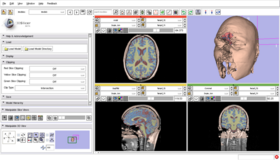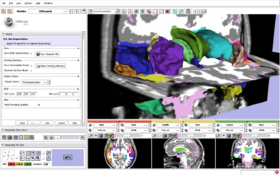Modules:EM-Segmenter-Documentation
Return to Slicer Documentation
Module Name
MyModule
General Information
Module Type & Category
Type: Interactive (Template Builder) and CLI (EMSegment Simple)
Category: Segmentation
Authors, Collaborators & Contact
- Kilian Pohl: Harvard
- Brad Davis: Kitware, Inc.
- Sebastien Barre: Kitware, Inc.
- Yumin Yuan: Kitware, Inc.
- Polina Golland: MIT
- Contact: Brad Davis, brad.davis@kitware.com
Module Description
The goal of this project is the creation of interfaces in Slicer3 that integrate the EMSegment algorithm (Pohl et al.), an automatic segmentation algorithm for medical images that previously existed in Slicer 2. As in Slicer 2, the user is able to adjust the algorithm to a variety of imaging protocols as well as anatomical structures and run the segmenter on large data sets. Three views or interfaces to the algorithm are available: a wizard-based module for building and editing parameter sets, a simplified "one-click" GUI module, and a command line interface for script and batch processing.
As of January, 2008, working versions of all EMSegment interfaces are complete and have been checked into the Slicer3 SVN repository. Recent development effort has focused on providing simplified interfaces to the algorithm, reducing assumptions about input data, testing, and validation. The module was demonstrated at the NAMIC All-Hands meetings in Salt Lake City (2007 and 2008). A tutorial has been developed and is available from this page.
EMSegment Workflow Module
The EMSegment worfklow module is the primary Slicer3 interface to the EMSegment algorithm. The target audience for this module is someone familiar with brain atlases and tissue labels, not a computer scientist. It allows the user to configure the algorithm---step-by-step---to a variety of imaging protocols and anatomical structures, and then apply the algorithm to segment data. Configuration settings are stored in an EMSegment parameters node in the Slicer3 MRML tree. These settings can be saved and later applied to new data via any of the EMSegment interfaces within Slicer3 or the command-line EMSegment executable.
A similar EMSegment module is available in Slicer2.6. The intent of this project is to implement a Slicer3 module with similar functionality while also improving the graphical user interface (GUI). While the GUI and data structure (MRML) code was completely rewritten for the Slicer3 module, the algorithm code was not modified.
EMSegment Command-line Executable
The EMSegment command-line executable is used to simplify the processing of large collections of images. The primary function of the work flow module is to step the user through the process of calibrating, via algorithm parameters, the segmentation algorithm to a particular set of input data. However, once a successful collection of parameters is established, the user will commonly want to bypass this detailed calibration process when segmenting new images. The command-line executable provides this batch processing capability.
The executable is included in the Slicer3 distribution.
The interface to the executable is both simple and flexible. It is simple because the number of command-line parameters is minimized---only a MRML scene (containing algorithm parameters), a target image (or multiple target images, e.g., T1 and T2), and an output labelmap image need to be specified. It is flexible because any EM algorithm parameter can be modified, within the MRML scene, via the EMSegment GUI interface.
The interface is under construction and subject to change; here is the current version.
Usage
Examples, Use Cases & Tutorials
- Note use cases for which this module is especially appropriate, and/or link to examples.
- Link to examples of the module's use
- Link to any existing tutorials
Quick Tour of Features and Use
List all the panels in your interface, their features, what they mean, and how to use them. For instance:
- Input panel:
- Parameters panel:
- Output panel:
- Viewing panel:
Development
The overall design of the EMSegmenter module is described in these slides.
The module is implemented as a programmatic Slicer3 module because it requires a large degree of interaction with the user, the data stored in the MRML tree, and the Slicer3 GUI itself. Because the MRML node structure is rather complicated (for example the anatomical tissue hierarchy and a large number of interdependent nodes) the Logic class is solely responsible for maintaining and accessing these nodes. The Logic class provides an API that the GUI code uses to access and modify data. The Logic class also wraps the algorithm code itself.
Dependencies
Slicer base modules.
Known bugs
Follow this link to the Slicer3 bug tracker.
Usability issues
The EMSegmenter can be adapted to many segmentation problems. However, there is no "default" set of parameters that will work for all segmentation problems.
- Atlas-to-target registration and intensity normalization are very important; it will be most effective to apply these steps using algorithms that are customized to your data. Defaults are provided but they may perform poorly for your data---this will lead to poor segmentation results.
Follow this link to the Slicer3 bug tracker. Please select the usability issue category when browsing or contributing.
Source code & documentation
Customize following links for your module.
More Information
For more information about the EM Segmenter project in Slicer3 see the old EMSegment Wiki page here
Acknowledgment
Funding for the EMSegmenter module was provided by NAMIC.
References
K.M. Pohl, S. Bouix, M. Nakamura, T. Rohlfing, R.W. McCarley, R. Kikinis, W.E.L. Grimson, M.E. Shenton, and W.M. Wells. A hierarchical algorithm for MR brain image parcellation. IEEE Transactions on Medical Imaging, 26(9),pp 1201-1212, 2007. bib | PDF


